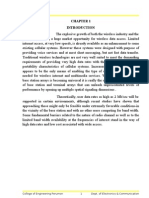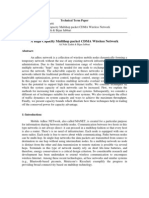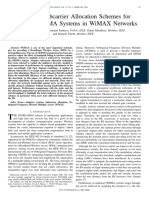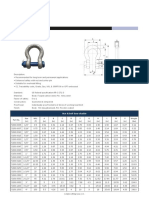Wireless Relays For Next Generation Broadband Networks
Wireless Relays For Next Generation Broadband Networks
Uploaded by
Sarunkumar BalathCopyright:
Available Formats
Wireless Relays For Next Generation Broadband Networks
Wireless Relays For Next Generation Broadband Networks
Uploaded by
Sarunkumar BalathOriginal Description:
Original Title
Copyright
Available Formats
Share this document
Did you find this document useful?
Is this content inappropriate?
Copyright:
Available Formats
Wireless Relays For Next Generation Broadband Networks
Wireless Relays For Next Generation Broadband Networks
Uploaded by
Sarunkumar BalathCopyright:
Available Formats
Wireless relays for next generation broadband networks
INTRODUCTION
Relaying has been an age-old concept for radio-range extension in long distance microwave communications. In its simplest form, a relay is a simple repeater-like device that receives a signal from some source, boosts it up, and resends it to the intended destination. However, depending on the complexity, relays may take part in higher level network functionalities. We will first outline the major challenges todays broadband networks face. We also highlight the important performance and cost benefits that relay stations could potentially offer and present some scenarios where relays are likely to be deployed. Next, different modes of relaying are presented, followed by a glimpse of the current wireless technologies that use relay. Some interesting real life implementation issues like whether to use two-hop or multi-hop relay and disadvantages of relay based systems are described as well. In wireless networks, mobile users use multi-mode terminals that are equipped with multiple air interfaces and adaptive protocols so that the same terminal can be used for different networks. Using these terminals, mobile users are always connected to the best available network or networks. When users move out of the coverage of the serving network, their terminals automatically switch to another network such that the applications do not experience connection interruption. Therefore, users perceive different wireless networks as a single integrated system. We refer to this integrated system as the
Dept of ECE Maliankara
SNMIMT
Wireless relays for next generation broadband networks
next-generation wireless systems (NGWS).The next generation wireless networks face new challenges in the form of increasing volume of traffic with the increase in number of users and the average traffic generated by users.
The concept of wireless relaying and its state of the art are then introduced, followed by a comprehensive description of a multi-hop relay system for WiMAX and related use cases. The article explains the impact of relays on network planning and presents an example of deployment cost analysis in different most traffic scenarios technologies and that propagation enables conditions. cost-effective Performance results show that multi-hop relaying is one of the promising enhancement of coverage, user through put, and system capacity, and is especially suitable for the emerging markets and rural areas.
Dept of ECE Maliankara
SNMIMT
Wireless relays for next generation broadband networks
CHAPTER 1
CONCEPT OF RELAYING
The classical three-node relaying model is a network consisting of only one source (mobile multi-hop relay-base station, MMR-BS), one relay (fixed, nomadic, or mobile relay station, F/N/MRS) and one destination (mobile station, MS, or user terminal, UT). (In the rest of the article we use UT to mean both fixed and mobile stations).The model was originally introduced by Van der Meulen in 1971. The three-node relay network can be seen as a primitive building block for larger relaying systems. As illustrated in Figure, the destination can receive the signal from the source via two paths: the two-hop relaying link (first and second hop) and the one-hop direct link (third hop). In the twohop relaying link the physical channel between the source and the relay is called the relay link and the physical channel between the relay and the destination is called the access link.
A relay path is by definition a concatenation of consecutive relay links between the source and the designated access relay station. The relay normally works in half-duplex mode, which means the station does not receive and transmit using the same
Dept of ECE Maliankara 3 SNMIMT
Wireless relays for next generation broadband networks
channel simultaneously. This is because it would be difficult to separate the received signal from the transmitted signal. For this reason, the channel allocated for the relay operation consists of two (ideally) orthogonal sub channels. For example, in TDD the orthogonal sub channels are two consecutive time slots: the relay receives during the first time slot and uses the second slot for retransmitting. Frequency or code-division duplex is also possible. The relay may operate in three possible schemes, depending on how it processes the received signal: Amplifying and Forwarding (AF), Decoding and Forwarding (DF), and Compress and Forwarding (CF). In the AF scheme (analog repeaters) the relay node just amplifies and retransmits symbols. The received signal is deteriorated by relay link fading and additive receiver noise. The degraded signal and noise are amplified and forwarded, thereby increasing the system noise level. In the DF scheme (digital repeaters or layer 2 relays) the relay demodulates and decodes the received signal before retransmission. In this case the forwarded signal does not contain additional degradation, only symbol errors resulting from it. In the EF scheme (hybrid solution) the relay does not decode the input data, but it source codes the received signal (after quantization) and transmits it to the destination. In this case the forwarded signal contains possible estimation errors. The destination uses the relay estimation as side information when coding the actual direct link signal.
Dept of ECE Maliankara
SNMIMT
Wireless relays for next generation broadband networks
CHAPTER 2
BROADBAND WIRELESS RELAY STATIONS
A relay station (RS) is a radio system that helps to improve coverage and capacity of a base station (BS). Relay station has other names such as repeater, or multi-hop station. Networks that use relay stations are sometimes called cooperative networks. Mobile operators can connect an RS to a BS by wire, by optical cable. It can also be connected by a radio link. The technical reason to deploy RS is to eliminate coverage holes in a cell. A coverage hole is an area in the cell where mobile phones cannot catch a signal from the base station. It happens when tall buildings obstruct the signal from base stations. It also happens in underground trains. The same situation can happen for wireless LAN terminals. Mobile operators use software tools and measurement instruments to find out where these coverage holes are. Then they must do something about them. The use of RS is one option to eliminate coverage holes. Another place where RS can help is near the edge of the cell. When mobiles are far, they naturally receive weaker signals from base stations. For
Dept of ECE Maliankara 5 SNMIMT
Wireless relays for next generation broadband networks
voice services, handoff helps to keep the subscribers connected. But for wireless data, throughput in mbps becomes very low.
CHAPTER 3
CHALLENGES FOR FUTURE BROADBAND NETWORKS
The principal challenges for future wireless networks are high throughput/ capacity, wide coverage, maximum mobility, scalability, and interoperability. But these demands are often incompatible in nature. For a fixed cell size, increasing data rate reduces reliability, since it is well known that for a given transmit power level, the symbol energy decreases linearly with the increasing transmission rate. On the other hand, to maintain minimum quality of service (QoS), a given signal-to-noise ratio (SNR) at the receiver is required (depending on the type of data service) that may be difficult to achieve at the cell edge unless the transmit power is increased, causing a reduction in effective coverage area. Limited battery life of mobile stations (MSs), however, dictates the upper limit on the transmit power in the uplink. Thus, the signal power cannot be increased arbitrarily to
Dept of ECE Maliankara 6 SNMIMT
Wireless relays for next generation broadband networks
maintain the same coverage area. Mobility of the moving nodes, coverage holes, dead spots due to geographical terrain, among others, all account for further degradation of data service. The spectrum for 4G systems will almost certainly be located at 23.5 GHz, which, in turn, limits the range of wireless broadband access networks and necessitates the use of increased number of base stations (BSs)/access points (APs) for the same coverage area. As per the current literature, for good quality indoor coverage in a suburban cellular environment, four times as many BSs are to be deployed at 2 GHz than at 1 GHz, and ten times as many for 3.5 GHz. Increasing the BS density (and thereby reducing the cell size) will obviously increase network capacity. This is mainly due to the increased frequency reuse, the same frequency band being repeated again and again for communication, now at a shorter distance. However, this strategy is not scalable due to several reasons. The geographical area covered by a cell has already been diminished from tens of kilo meters to a few meters as we moved from macro cell to micro cell to picocell and further to femto cellular domain. Not only will that, with each BS there be an additional cost for hardware equipment, antenna space, and the wired backhaul. Thus, adding abundant BSs is only feasible if the number of subscribers is also increased at a sufficient rate. This seems unlikely, with the penetration of cellular phones already high in developed countries. One may argue that the transmit power requirement is lesser for these Pico or femto cells. But with the growth of BSs, the increased interference (both
Dept of ECE Maliankara
SNMIMT
Wireless relays for next generation broadband networks
co channel and adjacent-channel type) would soon outweigh the benefits of limiting the signal power.
CHAPTER 4
ADVANTAGES OF RELAYING
Installation of relay stations (RSs) can help in overcoming some of the major challenges that are faced by present day wireless broadband networks. The advantages are mainly threefold: first, RSs improve overall network performance by enhancing coverage, capacity, and power efficiency. Second, both implementation and maintenance costs may be lowered by
Dept of ECE Maliankara 8 SNMIMT
Wireless relays for next generation broadband networks
incorporating relays at various stages of network rollout. Finally, RSs may play an important role in optimizing network and higher level functions such as routing and load balancing. The next three subsections describe these benefits in more detailed
4.1 NETWORK PERFORMANCE IMPROVEMENT
Fig. 1 illustrates how the use of RSs affects the two key network performance metrics: coverage and capacity. Let us focus on the coverage first. A BS/AP, compared to a conventional one-hop system, can cater much larger cells with the help of several fixed RSs.
As shown in Fig. 1, the mobile station on the right (MS1), although residing outside the traditional service boundary, may still get service if an RS is placed between the BS and mobile station. When radio range is not an issue, better radio coverage
Dept of ECE Maliankara
SNMIMT
Wireless relays for next generation broadband networks
inside the existing cell may be realized, especially in areas heavily shadowed from a BS/AP (urban indoor coverage holes or rural coverage holes created by foliage or rough terrain). Of course nothing comes for free, and the price we have to pay in this case is reduced capacity and increased latency. Relays generally work in store and forward mode. For a two-hop system in the downlink (uplink) the signal through BS-RS (MS-RS) is stored in relay and in the next time slot is forwarded through RS-MS (RS-BS) link. The network capacity falls as MS-RS and BSRS links operate at different times using same wireless band ( inband relaying). The capacity advantage with relaying comes mainly from the exploitation of path or site diversity. To exemplify the fact, let us take another look at Fig. 1, where the MS2 is served by two RSs simultaneously. Wireless links are subjected to fading (path loss and shadowing), resulting in loss of information and frequent link failure/outage. If two or more alternate paths are available via different RS, then the MS can switch to the RS having the strongest signal. As fading occurs independently in different paths, it is very unlikely that the signal will experience deep fading in all the paths at a given point of time. It is important to understand that this capacity increment is feasible only if the BS and RS employ orthogonal channels, i.e., BS-RS and RS-MS links are operating at the same time but at different frequency bands (also known as out-of band relaying). As it is difficult to install multiple antennas in a small mobile unit, cooperative relaying with simultaneous transmission through RSs may provide an alternative to conventional multiple-input, multiple-output (MIMO) techniques. There is yet another possibility of capacity gain
Dept of ECE Maliankara
10
SNMIMT
Wireless relays for next generation broadband networks
through frequency reuse if the RSs form smaller cells within the cell served by main BS.
Relays, when employed in the uplink path, replace longrange, high-power transmission to a BS with short-range, low power relay transmissions. This enhances the lifetime of batterydriven MSs. As far as power consumed by RSs is concerned, they require only mains supply. To save energy, relays could even rely on solar power supply.
4.2 COST BENEFITS
The RS concept opens up the possibility of installing temporary coverage in areas where permanent connections are not needed (e.g., construction sites or conference/meeting rooms). In case a fast initial network rollout has to be performed, relay-based solutions are economically more attractive compared to traditional BSs networked via wired backhaul. RSs enable lesser capital expenditures (CapEx) in terms of infrastructure hardware as cellular networks with relays allowing low-height antennas, low-gain amplifiers, and relay nodes do not need a copper/fiber wired backhaul. Also, RS cell sites are likely to be less expensive than BS cell sites, smaller in size and hence, allow greater flexibility in site selection. Further, with relays, operating expenditures (OpEx) such as tower leasing and maintenance costs are trimmed. Once a network has been set up, the up gradation required for an increased number of subscribers or time-varying subscribers may be performed by replacing some of these RSs with BSs in a gradual manner. This approach provides
Dept of ECE Maliankara
11
SNMIMT
Wireless relays for next generation broadband networks
a way out for many of the network operators to sustain their business at a time of a great worldwide recession.
4.3 OTHER ADVANTAGES
Apart from the performance and cost benefits, the introduction of relays offers several other advantages. By regulating traffic from congested (hot) to non-congested (cool) cells in unlicensed frequency bands, relaying reduces call blocking probability and improves quality of service (QoS) of end users. This kind of load balancing between the neighboring cells, cell A and cell B, has been depicted in Fig. 2. To understand the situation better, let us assume that all the MSs are residing in the service area allotted to BSA, and there is only a single frequency
Dept of ECE Maliankara 12 SNMIMT
Wireless relays for next generation broadband networks
available for communication between MS and BS. Now if both MS1 and MS2 want to make a call but MS1 takes hold of the common channel first, then the call from MS2 is blocked. However, the blocked call may be completed through BSB if MS2 can forward the call through a nearby RS (controlled by BSB), provided that BSB is currently not engaged. This method is known as primary relaying
A second kind of relaying, known as secondary relaying, may also be realized in the following manner. Suppose MS3 is currently communicating through BSA, MS1 also expresses its willingness to enter the network, and MS2 is idle. As there is no RS in the vicinity of MS1, it is not possible to execute primary relaying. To maximize resource utilization, MS1 may be allotted the direct line through BSA, and MS3 may establish a relayed communication link to BSB. Some other advantages of relaying include integration of heterogeneous wireless networks, ad hoc relaying to enhance multicast throughput, and, above all, to provide stability to networks with an ever-increasing subscriber base.
Dept of ECE Maliankara
13
SNMIMT
Wireless relays for next generation broadband networks
CHAPTER 5
APPLICATION SCENARIOS
Dept of ECE Maliankara
14
SNMIMT
Wireless relays for next generation broadband networks
There are a multitude of possible applications for relays as demonstrated in Fig.3. Depending on the wireless environment, these applications can be classified into three major categories: fixed, nomadic, and mobile. Involved RS nodes may be either standalone devices ( fixed infrastructure mode) or simply normal MSs that are idle (ad hoc mode) for the time being. 1. Fixed relay station (F-RS): Fixed relay stations are used in the fixed infrastructure/buildings reliability. 2. Nomadic relay station (N-RS) Nomadic relay stations are used in the time varying situations like hotspots etc. 3. Mobile relay station (M-RS) A mobile RS can be mounted on a vehicle (bus, train, or ferry) where several people moving quickly through cells. The next three subsections describe these applications in more detailed to improve the coverage or
5.1 FIXED RELAY STATION (F-RS)
Fixed-infrastructure relays, like BSs, may be deployed by the service provider/ end users to improve coverage, reliability, or per user throughput in areas not sufficiently covered (in-building, shadowed regions like the valley between high risers, tunnels, underground metro rail, subways, or at cell edge) or in densely populated areas (railway terminus, bus stand, amusement park, or stadium). In rural areas where the traffic density is low and the population is sparsely distributed, it may not be economically viable to build traditional
Dept of ECE Maliankara 15 SNMIMT
Wireless relays for next generation broadband networks
cellular networks with full-fledged BSs. Rather, a more efficient and flexible architecture would be a single BS served by many RS nodes.
5.2 NOMADIC RELAY STATION (N-RS)
Broadband networks are often faced with the challenge of time-varying unbalanced traffic in hot-spots. Hot spots mostly occur due to events where a large group of people are densely packed into a small area (a fair, exhibition, or downtown areas on Monday morning). Since the locations of hot spots vary from time to time, it is difficult, if not impossible, to provide the guarantee of sufficient resources in each cell in a cost effective way. Lowpower, low-complexity portable nomadic relays may be employed to enhance coverage required only for the duration of a particular event. These kinds of temporary relays also can be deployed in emergency/disaster recovery situations (natural calamities like floods, earth quakes, cyclones, or for damaged BSs).The idea of nomadic relays basically imitates the well-known, selforganizing, infrastructure-free, ad-hoc approach where MSs establish connections in a distributed peer-to-peer fashion and dynamically adapts to the fast-changing wireless environment.
5.3 MOBILE RELAY STATION (M-RS)
A mobile RS can be mounted on a vehicle (bus, train, or ferry) where several people are located very closely together and the vehicle is moving quickly through cells. The RS provides a
Dept of ECE Maliankara 16 SNMIMT
Wireless relays for next generation broadband networks
fixed access link to terminals residing on the public transport platform. However, with mobility being the biggest issue, the mobile RSs should be able to mitigate velocity related effects such as Doppler fading.
CHAPTER 6
RELAYING METHODS
Dept of ECE Maliankara
17
SNMIMT
Wireless relays for next generation broadband networks
Depending on how an RS processes the received signal, there exist mainly three different physical layer realizations for relaying: Amplify and Forward (AF) Method Decode and Forward (DF) Method
Compress and Forward (CF) Method The next three subsections describe these methods in more detailed.
6.1 AMPLIFY AND FORWARD (AF) METHOD
AF is the simplest possible relaying scheme where the relays act as analog repeaters (layer 1 relay). Fig. 4 describes a simple AFtype relay in operation. To keep the complexity of the analysis to a minimum, let us consider the downlink path only. The transmitted signal (S) from a BS/AP is first received by a relay node, amplified with a gain (G), which may be adaptable if channel state information (CSI) is available, and finally retransmitted to the destination (D) MS.
Dept of ECE Maliankara
18
SNMIMT
Wireless relays for next generation broadband networks
The terms hSR and hRD account for the channel attenuation due to fading, and nSR and nRD denote additive noise, in the sourcerelay (SR) and relay destination (RD) links respectively. The received signal at relay node may be expressed as
And at destination
Finally combining (1) and (2) through the relation
We get,
As demonstrated in (3), during the amplification process, variations due to fading and noise that has been accumulated in BS-RS transmission are also magnified. The signal S experiences double fading instead of single fading present in a simple MS-BS transmission and additional noise terms do appear. To compensate, the noise and fading effect a variable gain at RS is generally proposed. If perfect CSI is available at all instants of time, this gain G may be made inversely proportional to the fading attenuation and noise. The corresponding method is known as instantaneous power scaling (IPS). However, in reality, it is not possible to assess the
Dept of ECE Maliankara 19 SNMIMT
Wireless relays for next generation broadband networks
instantaneous channel fading all the time. Accordingly, a variable gain proportional to the inverse of average noise/fading is found to be more suitable. This is known as the average power scaling (APS) approach.
6.2 DECODE-AND-FORWARD (DF)
In DF mode, RSs act as digital regenerative demodulates, repeaters decodes, (layer 2 relay), and i.e., the relay the re-encodes re-modulates
received signal prior to retransmission. The forwarded signal does not contain additional degradation; rather it is affected by only bit errors resulting from the decoding process. To improve reliability, the DF relay may be allowed to retransmit only if the decoding is satisfactory; otherwise an automatic repeat request (ARQ) algorithm takes care of it. Compared to AF strategy, the DF scheme provides better QoS. But an increase in cost, complexity, and power consumption is involved on the part of relay nodes.
6.3 COMPRESS-AND-FORWARD (CF)
The CF scheme is a hybrid solution, an attempt to retain the better features of both AF and DF strategies. In this method, the RS does not decode the input data, but it quantizes and compresses (via source coding) the received signal and transmits it to the destination. The possible estimation errors in quantization and coding process are the main sources of signal degradation in this case. CF is also sometimes referred to as estimate-and-forward (EF) technique.
Dept of ECE Maliankara
20
SNMIMT
Wireless relays for next generation broadband networks
CHAPTER 7
MULTIHOP OR DUAL-HOPS?
In order to meet the coverage and throughput demand, when a single-hop link between an MS and a BS/AP is converted to a dual-hop wireless channel by inserting a RS between them, it seems natural to extend the process by putting a few more RSs when the demand grows further. However, one should keep in mind that RSs close to BS/AP have to carry traffic originated from and destined to multiple MSs and RSs; traffic aggregation occurs and tends to grow larger with an additional number of hops. The congestion with multi-hop forwarding will be at its peak at the RS nearest to BS. When all RSs share common cellular bandwidth, exposed terminal problem will also be intensified, rendering the random medium access protocols inefficient. Because of unnecessary congestion and a rise in media access time, the overall end-to-end packet delay would increase. On the other hand, due to node mobility and radio signal strength fluctuation, the routing path from the source node to the destination node could easily become invalid. Frequent route changes and the resulting route discovery procedures could cause high signaling overheads. No wonder IEEE 802.11 has been reported not to perform well in multi-hop relay environments. Considering packet delay, signaling overhead, and system
Dept of ECE Maliankara 21 SNMIMT
Wireless relays for next generation broadband networks
complexity, simple dual-hop relay implementation may appear better in contrast to the multi-hop case.
Dept of ECE Maliankara
22
SNMIMT
Wireless relays for next generation broadband networks
CHAPTER 8
NETWORK TOPOLOGY
The interconnections between nodes include the following types of links: MMR-BS to UT, where the MMR-BS can associate with multiple UTs;RS to UT, where RS can associate with multiple UTs; MMR-BS to RS, where the MMR-BS can associate with multiple RSs; and RS to RS, where RSs can associate among themselves. In all usage models described in the previous section, all data communications may occur between MMR-BS and MSs directly, or through one or more RSs. Downlink and uplink communications between the MMR-BS and UTs can occur via either symmetric or asymmetric routes. Multiple routes between an MMR-BS and a UT are also possible.
Dept of ECE Maliankara
23
SNMIMT
Wireless relays for next generation broadband networks
CHAPTER 9
STATE OF ART
The boost in research interest for relay based deployment can be substantiated by citing some of the activities of standardization bodies throughout the world. From a seed concept in the 3rd Generation Partnership Project (3 GPP) under the name opportunity driven multiple access (ODMA), multihop relaying has now flourished to 3 G LTE release 9, and probable mesh extensions in the later release IEEE 802.16 m. Significant thrust to relay research came with the establishment of IEEE 802.16j task group in March 2006. The IEEE 802.16j amendment is primarily meant to incorporate mobile multihop relay (MMR) capabilities in the current IEEE 802.16 WiMAX standard to enhance end user coverage, and throughput, and system capacity. The with standard does not impose any modification on the part of provides and full backward 802.16e-2005 compatibility 802.16-2004 systems. Fixed relay stations acting as wireless bridges have also been suggested as an overlay to cellular radio systems extending the coverage of media access control frame-based access proto-cols HiperLAN/2. researchers In even like IEEE 802.11 of and 802.15.3 and the presence diverse data networks, (fixed) (mobile) WiMAX
proposed two-hop relay architecture, which
integrates a wireless wide area network (WWAN) with a wireless local area network (WLAN), and thereby enhancing the system capacity of existing WWAN as well as improving coverage of WLAN.
Dept of ECE Maliankara
24
SNMIMT
Wireless relays for next generation broadband networks
Dept of ECE Maliankara
25
SNMIMT
Wireless relays for next generation broadband networks
CHAPTER 10
DISADVANTAGES OF RELAYING
In its basic form, a wireless relay enhances radio range at the cost of capacity, as every RS works either in timesharing or in a frequency-sharing basis. In time-division duplexing (TDD) mode the relay receives a signal from BS during the first time slot and uses the second slot for retransmission. This results in reduction of data rate, since the relayed data has to go twice over the radio channel. If a frequency-division duplexing (FDD) technique is used instead; orthogonal frequency bands are used for simultaneous BS-RS and RS-MS communication, which reduces the effective bandwidth, not to mention the complexity and cost incurred due to multiple radio interfaces. For relatively smaller cells, where a BS-MS link is operating satisfactorily, relay deployment would unnecessarily eat up the capacity of the network. Even worse, using relay may cause unintended accumulation of noise, fading effects, delay, and interference. Therefore, it seems relays should be adopted only if there exists a direct reliable line-of-sight BS-RS path, overcoming the deteriorations of random non LoS BS-MS channels. A detailed cost analysis is also necessary because implementing relay is not the only way to extend coverage, and thus it must be the most cost-effective approach. Finally, it remains to be seen how wireless relays will as perform against other competing division technologies, such MIMO-orthogonal frequency
multiplexing, femto BSs, and software defined radio.
Dept of ECE Maliankara
26
SNMIMT
Wireless relays for next generation broadband networks
CHAPTER 11
CONCLUSIONS
Wireless radio relays are one of the possible contenders to extend the capacity and reliability of broadband data channels envisaged for 4G and above. Several research and standardization groups are engaged in evaluating and evolving the range of applications with radio relays. There are both pros and cons of this technology, which needs to be carefully addressed before its actual implementation. Its cost effectiveness will also be a deciding factor in a particular application scenario with respect to other competing technologies. Relay technology to extend coverage and capacity has been receiving much attention due to its simplicity, flexibility, speed of deployment, and cost effectiveness. This is particularly so in scenarios where first responders need to communicate in disaster and emergency situations. Relaying also offers an economical way to deliver broadband data to rural communities where distances may be large and population density sparse. Some key advantages of relays are: No backhauling required, resulting in lower CAPEX and OPEX. Flexibility in locating relays.
Dept of ECE Maliankara
27
SNMIMT
Wireless relays for next generation broadband networks
When located in a cell, relays can enlarge the coverage area Decreased transmit power and interference. Mobile relays enable fast network rollout, indoor-outdoor service However, relaying is not without some disadvantages, such as increased use of radio resources in in-band relaying (in the time domain) and need for multiple transceivers in out-of-band relaying (in the frequency domain). Relays also introduce additional delays. Further-more, it remains to be seen how wireless relays will compete against other technologies, such as femto BSs, and conventional broadband networks that use lower carrier frequencies and optimized backhauling, such as xDSL and passive optical networks. Overall, wireless relays offer great advantages, and will continue to receive a lot of attention in both the research and business communities.
Dept of ECE Maliankara
28
SNMIMT
Wireless relays for next generation broadband networks
CHAPTER 12
REFERENCES
From pdf. K. J. Rayliu, A. K. Sadek, W. Su, and A.Kwasinski,
Cooperative Communications and Networking. New York: Cambridge Univ. Press, 2009 IEEE 802.16s Relay Task Group. (2009, June). IEEE Standard for Local and Metropolitan Area Networks Part 16: Air Interface for Broadband Wireless Access Systems. S.W.Peters and R.W.Heath, The future of WiMAX: Multihop relaying with IEEE 802.16j, IEEE Commun. Mag., vol. 47 From internet Websites: www.ieee802.org/16/relay www,wikipedia.com
Dept of ECE Maliankara
29
SNMIMT
Wireless relays for next generation broadband networks
Dept of ECE Maliankara
30
SNMIMT
You might also like
- Dokumen - Pub Haynes Land Rover Freelander 97 06 Owners Workshop Manual 0857338749 9780857338747Document420 pagesDokumen - Pub Haynes Land Rover Freelander 97 06 Owners Workshop Manual 0857338749 9780857338747josefzammit15100% (1)
- Concise Guide to OTN optical transport networksFrom EverandConcise Guide to OTN optical transport networksRating: 4 out of 5 stars4/5 (2)
- Operator'S: NoticeDocument56 pagesOperator'S: NoticeGabriela100% (2)
- c2165 Mouse SocDocument12 pagesc2165 Mouse SocEinar César Santos50% (4)
- Bock Open Compressors Type FDocument29 pagesBock Open Compressors Type Fembasian100% (5)
- CP02 Course - Motorola - GSM All in One: Features, Components, Interfaces, Call Flow.Document124 pagesCP02 Course - Motorola - GSM All in One: Features, Components, Interfaces, Call Flow.Xuan Hong MaiNo ratings yet
- Fiber Optic System DesignDocument21 pagesFiber Optic System DesignSyaa MalyqaNo ratings yet
- Simulation of Digital Communication Systems Using MatlabFrom EverandSimulation of Digital Communication Systems Using MatlabRating: 3.5 out of 5 stars3.5/5 (22)
- Template Printing OnlyDocument15 pagesTemplate Printing OnlyKelly LuluNo ratings yet
- Chancadores de ConosDocument60 pagesChancadores de Conosvalentina_brune6307100% (8)
- IJCER (WWW - Ijceronline.com) International Journal of Computational Engineering ResearchDocument5 pagesIJCER (WWW - Ijceronline.com) International Journal of Computational Engineering ResearchInternational Journal of computational Engineering research (IJCER)No ratings yet
- ElysiumDocument61 pagesElysiumRama SubramaniamNo ratings yet
- Eng Performance BrindhaDocument8 pagesEng Performance BrindhaImpact JournalsNo ratings yet
- Wi Max RelaysDocument22 pagesWi Max Relaysfeku fekuNo ratings yet
- Wimax System Performance StudiesDocument10 pagesWimax System Performance StudiesFelix GatambiaNo ratings yet
- Past Exams IoTDocument9 pagesPast Exams IoTandreaNo ratings yet
- Title - Multiple Input Multiple Output: SubjectDocument9 pagesTitle - Multiple Input Multiple Output: Subjectswapnil32No ratings yet
- Node B: FunctionalityDocument4 pagesNode B: FunctionalityMinto IssacNo ratings yet
- Smart Antennas For Broadband Wireless Access Networks: (Paper Appeared in IEEE Communication Magazine, Nov. 1999)Document17 pagesSmart Antennas For Broadband Wireless Access Networks: (Paper Appeared in IEEE Communication Magazine, Nov. 1999)Anonymous 0L2mVaINo ratings yet
- CDMA Array Processing by Peter M. GrantDocument10 pagesCDMA Array Processing by Peter M. GrantDebby FitraNo ratings yet
- 00904804Document6 pages00904804Satish NaiduNo ratings yet
- Rohde and Schwarz Assessing A MIMO Channel White PaperDocument18 pagesRohde and Schwarz Assessing A MIMO Channel White Paperjkenny23No ratings yet
- Introduction To Communication SystemDocument11 pagesIntroduction To Communication SystemkirankumarikanchanNo ratings yet
- Link-Level Performance Evaluation of Relay-Based Wimax NetworkDocument19 pagesLink-Level Performance Evaluation of Relay-Based Wimax NetworkJohn BergNo ratings yet
- Distributed Wireless Communication SystemDocument28 pagesDistributed Wireless Communication SystemArjunhunts007No ratings yet
- Multihop Relaying in Wimax: Cooperative Principles and Relay RoutingDocument11 pagesMultihop Relaying in Wimax: Cooperative Principles and Relay RoutingNarayanan AnbuNo ratings yet
- A Simple Transmit Diversity Technique For Wireless CommunicationsDocument8 pagesA Simple Transmit Diversity Technique For Wireless Communicationshanlee890No ratings yet
- Performance Enhancement of Wi-Max Mobile Handover Ofdm Using M-Qam System With Best-Relay SelectionDocument8 pagesPerformance Enhancement of Wi-Max Mobile Handover Ofdm Using M-Qam System With Best-Relay SelectionIAEME PublicationNo ratings yet
- ACN Sample Paper 1Document9 pagesACN Sample Paper 1Apoorv SarafNo ratings yet
- 5.another Format Paper 2Document6 pages5.another Format Paper 2iisteNo ratings yet
- BT0086: Mobile Computing - AssignmentDocument6 pagesBT0086: Mobile Computing - AssignmentPawan Mall100% (1)
- Whymax: Abdul Rehman UsmaniDocument5 pagesWhymax: Abdul Rehman UsmaniHassan AtiqueNo ratings yet
- Rahu FinalDocument14 pagesRahu FinalkirankumarikanchanNo ratings yet
- Performance Analysis of An Efficient Wireless Communication System in AWGN and Slow Fading ChannelDocument10 pagesPerformance Analysis of An Efficient Wireless Communication System in AWGN and Slow Fading Channelsinghrps1941No ratings yet
- Cell Coverage Area and Link Budget Calculations in GSM SystemDocument7 pagesCell Coverage Area and Link Budget Calculations in GSM SystemMustaf MohamedNo ratings yet
- Holographic Beamforming WP v.6C FINALDocument8 pagesHolographic Beamforming WP v.6C FINALsameerNo ratings yet
- Blast: College of Engineering Perumon 1 Dept. of Electronics & CommunicationDocument23 pagesBlast: College of Engineering Perumon 1 Dept. of Electronics & CommunicationInduchoodan RajendranNo ratings yet
- 5314sipij06 PDFDocument11 pages5314sipij06 PDFelhamNo ratings yet
- Wireless Communication: 1) Transmission ModesDocument8 pagesWireless Communication: 1) Transmission ModesWasim WaseemNo ratings yet
- Smart Antenna For Wi-Max Radio System: Neha Shrivastava, Sudeep Baudha, Bharti TiwariDocument7 pagesSmart Antenna For Wi-Max Radio System: Neha Shrivastava, Sudeep Baudha, Bharti TiwariIjarcet JournalNo ratings yet
- System Architecture For Power-Line Communication and Consequences For Modulation and Multiple AccessDocument6 pagesSystem Architecture For Power-Line Communication and Consequences For Modulation and Multiple Accessrenum82No ratings yet
- Overview of Wireless Channel Models For UMTS and LTE: Abbas Mohammed and Asad MehmoodDocument36 pagesOverview of Wireless Channel Models For UMTS and LTE: Abbas Mohammed and Asad MehmoodIgor MalianovNo ratings yet
- 2 CDMA Concept: A. IntroductionDocument9 pages2 CDMA Concept: A. IntroductionAlexander MccormickNo ratings yet
- Performance Analysis of Efficient and Low Complexity MIMO-OFDM Using STBC and V-BLASTDocument66 pagesPerformance Analysis of Efficient and Low Complexity MIMO-OFDM Using STBC and V-BLASTDheeksha ReddyNo ratings yet
- Smart Antenna IeeeDocument4 pagesSmart Antenna Ieeervsharma02No ratings yet
- Unit-5 Lightwave Systems: 1. System ArchitecturesDocument24 pagesUnit-5 Lightwave Systems: 1. System ArchitecturesRidhi JainNo ratings yet
- Final ReportDocument57 pagesFinal ReportJay BavarvaNo ratings yet
- Mobile Computing Synopsis UNIT-1: Generations of Wireless Mobile SystemsDocument25 pagesMobile Computing Synopsis UNIT-1: Generations of Wireless Mobile SystemsNuthanKumarReddyNo ratings yet
- Broadband Millimeter Wave MIMODocument5 pagesBroadband Millimeter Wave MIMOManjusha SreedharanNo ratings yet
- A High Capacity Multihop Packet CDMA Wireless Network: Ali Nabi Zadeh & Bijan JabbariDocument16 pagesA High Capacity Multihop Packet CDMA Wireless Network: Ali Nabi Zadeh & Bijan JabbariSapna PatilNo ratings yet
- Channel EstimationEqualization With Adaptive Modulation and Coding Over Multipath Faded Channels For WiMAXDocument8 pagesChannel EstimationEqualization With Adaptive Modulation and Coding Over Multipath Faded Channels For WiMAXMarouaneSalhaouiNo ratings yet
- Tendai B Chingwena. 2206assDocument7 pagesTendai B Chingwena. 2206assBright Tendai ChingwenaNo ratings yet
- 2 Overview of Exixting Cdma SystemDocument6 pages2 Overview of Exixting Cdma SystemUdhaya SundariNo ratings yet
- Meppt 1Document24 pagesMeppt 1Pravin Prakash AdivarekarNo ratings yet
- Wireless Communications: Some Recent Developments and Some On-Going ProjectsDocument35 pagesWireless Communications: Some Recent Developments and Some On-Going ProjectsSantosh P LaksmeshwarNo ratings yet
- GSM SystemDocument118 pagesGSM SystemLim KimtengNo ratings yet
- Cellular Network: Özge Bengür Merih Miran S.Burak SarıgölDocument47 pagesCellular Network: Özge Bengür Merih Miran S.Burak SarıgölChibueze Ezeokafor100% (1)
- Improving The System Spectral EfficiencyDocument5 pagesImproving The System Spectral Efficiencypchopade1238374No ratings yet
- Adaptive Subcarrier Allocation Schemes For Wireless Ofdma Systems in Wimax NetworksDocument9 pagesAdaptive Subcarrier Allocation Schemes For Wireless Ofdma Systems in Wimax NetworksBhavya SwamyNo ratings yet
- Sensus+White+Paper Mesh+vs+PTMP+NetworksDocument8 pagesSensus+White+Paper Mesh+vs+PTMP+Networksharoldc4No ratings yet
- Signal Integrity: From High-Speed to Radiofrequency ApplicationsFrom EverandSignal Integrity: From High-Speed to Radiofrequency ApplicationsNo ratings yet
- Full-Duplex Communications for Future Wireless NetworksFrom EverandFull-Duplex Communications for Future Wireless NetworksHirley AlvesNo ratings yet
- Modeling and Dimensioning of Mobile Wireless Networks: From GSM to LTEFrom EverandModeling and Dimensioning of Mobile Wireless Networks: From GSM to LTENo ratings yet
- High-Performance D/A-Converters: Application to Digital TransceiversFrom EverandHigh-Performance D/A-Converters: Application to Digital TransceiversNo ratings yet
- PhysicsDocument101 pagesPhysicsSarunkumar BalathNo ratings yet
- New Doc 2018-01-21Document1 pageNew Doc 2018-01-21Sarunkumar BalathNo ratings yet
- Physics Mechanical Properties of Solids (Practice Problems) : Important FormulaeDocument2 pagesPhysics Mechanical Properties of Solids (Practice Problems) : Important FormulaeSarunkumar Balath100% (2)
- Untitled DocumentDocument1 pageUntitled DocumentSarunkumar BalathNo ratings yet
- IT SyllabusDocument75 pagesIT SyllabusFiroz FizzNo ratings yet
- Ak 37Document2 pagesAk 37Sarunkumar BalathNo ratings yet
- Nodia and Company: Gate Solved Paper Electronics & Communication General ApitudeDocument16 pagesNodia and Company: Gate Solved Paper Electronics & Communication General ApitudeSarunkumar BalathNo ratings yet
- C ProgramsDocument10 pagesC ProgramsSarunkumar BalathNo ratings yet
- Punjab InsurgencyDocument10 pagesPunjab InsurgencySarunkumar BalathNo ratings yet
- Session - I Microprocessors-The Solution in Search of ProblemsDocument75 pagesSession - I Microprocessors-The Solution in Search of ProblemsSarunkumar BalathNo ratings yet
- Heart Rate Profile: Bluetooth®Document21 pagesHeart Rate Profile: Bluetooth®Sarunkumar BalathNo ratings yet
- TROUBLESHOOTINGDocument9 pagesTROUBLESHOOTINGASMAA NOORUDHEENNo ratings yet
- Week 05 - Mechanical Properties Part 1Document48 pagesWeek 05 - Mechanical Properties Part 1Dharshica MohanNo ratings yet
- Conpipe Company BrochurefDocument16 pagesConpipe Company BrochurefDURGAPRASAD JANYAVULANo ratings yet
- Meter BasicsDocument11 pagesMeter BasicsSum Tin RungNo ratings yet
- Shot PeeningDocument5 pagesShot PeeningRam KumarNo ratings yet
- VIO 30 e 35 - Manual de Peças Motor 0CB10 A G75900Document25 pagesVIO 30 e 35 - Manual de Peças Motor 0CB10 A G75900Fernando Toniasso100% (1)
- Listado Status Audio PúblicoDocument2 pagesListado Status Audio Públicoesteban alvarezNo ratings yet
- Shackles: 5150 - Nut & Bolt Bow ShackleDocument1 pageShackles: 5150 - Nut & Bolt Bow ShackleAlthaf R100% (1)
- I Clock 700Document2 pagesI Clock 700pruebas pruebasNo ratings yet
- Structure Lightning ProtectionDocument4 pagesStructure Lightning ProtectionAndes PutraNo ratings yet
- AQU4518R24V06Document2 pagesAQU4518R24V06luca_allegrettiNo ratings yet
- Boiler DrumDocument42 pagesBoiler Drummetasoniko10% (1)
- Directorate of Technical Education, Maharashtra State MumbaiDocument6 pagesDirectorate of Technical Education, Maharashtra State Mumbaiमनोज चौधरीNo ratings yet
- 250/150 PSI DJ Series Butterfly Valves: Code Number SystemDocument3 pages250/150 PSI DJ Series Butterfly Valves: Code Number SystemIlyasaNo ratings yet
- KINGSUN CTI Certified (HKD) Cross-Flow Cooling Tower CatalogueDocument9 pagesKINGSUN CTI Certified (HKD) Cross-Flow Cooling Tower CataloguehyperchandikaNo ratings yet
- 2023-6-23-Minutes of Monthly Coordination Meeting - 06 (PIU, PIC & KRJV) DraftDocument7 pages2023-6-23-Minutes of Monthly Coordination Meeting - 06 (PIU, PIC & KRJV) DraftSivamurugan SivanayagamNo ratings yet
- Fuses and Circuit Breakers PDFDocument5 pagesFuses and Circuit Breakers PDFOskars ŠtālsNo ratings yet
- Reaction of A Continous BeamDocument7 pagesReaction of A Continous BeamMuhammad TarmiziNo ratings yet
- US CAT Niagara Cutter Catalog GT17-136Document342 pagesUS CAT Niagara Cutter Catalog GT17-136MANUEL VICTORNo ratings yet
- SECTION 08 14 00 Interior Wood DoorsDocument8 pagesSECTION 08 14 00 Interior Wood DoorsAlronavee MambajeNo ratings yet
- 4 Merox Kero JetDocument2 pages4 Merox Kero Jetfarhansualeh100% (4)
- Brochure PETDocument20 pagesBrochure PETSalustra A. Solarte VetancourtNo ratings yet
- NeoScreener - Manual enDocument16 pagesNeoScreener - Manual enSouthern California Public RadioNo ratings yet
- Chemical EngineeringDocument6 pagesChemical EngineeringNaveen TNo ratings yet




































































































